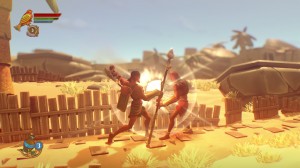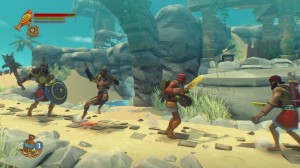Milkstone studios has certainly gone in a different direction from their last game: The FPS rogue-like RPG Ziggurat. With Pharaonic the developers have essentially created Egyptian Dark Souls. With a combat system built from the ground up, the game is a very impressive start, but does it do enough things right to earn the Dark Souls mantle?
Rising Up:
The story of Pharaonic tasks you as the chosen one destined to save Egypt from the Red Pharaoh who has enslaved the people. After creating a character, you’ll find yourself in the dungeons and have to escape with nothing but a torch and the clothes on your back.
Each area of the game is 2.5D, but you’ll cross in and out of the plain when transitioning between sections. As with Dark Souls, combat is skill-based and challenging. You’ll need manage your health and stamina during fights; with the ability to recover health using limited charge drinks from your canteen.
You have both light and heavy attacks to use, along with the ability to block, parry and dodge out of the way of attacks. Combat is fast and despite taking place on a 2D plane, you will have to deal with multiple enemies. The enemy AI is decent; they also have access to the same means of avoiding damage and can mix up their combos to some extent.
One area where Pharaonic differs is with having different enemy types and weapons that change combat up. Larger enemies cannot be blocked or parried, while spear users can attack enemies who dodge. One-on-one they make for interesting encounters, but when tagged team, it can make combat very crazy.
Progression comes in several forms and helps to keep you motivated. Weapons and gear are set and can be found either off of enemies or in placed chests throughout the levels. A skill system allows you to spec your character however you see fit and requires you to spend gems at a trainer to improve your ability to use specific weapon and armor types. As with Dark Souls, when you die, your experience will drop at your death spot and can be recovered, but you can have multiple spots and they don’t disappear if you die again.
Even though you do level up, there aren’t any stats to manage in Pharaonic; leveling simply raises your health pool and stamina; learning how to fight and deal with the enemies is the only way to really proceed in the game.
There is a lot here to digest, especially for fans of Milkstone’s previous games. Pharaonic definitely scratches that hardcore action/adventure itch, but it does have some sore spots and what prevents it from sitting next to the Souls series.
Struck Down:
As with the Souls games, Pharaonic is one of those games where you’re going to be knocked down a lot and forced to repeat areas. The game’s level design is probably the biggest strike against it when compared to the Souls games that are known for amazing and interesting levels. Due to the limitations of the 2D plane, levels are essentially winding corridors that are very hard to keep track of where you are. While you can buy or find maps for each, it can be very confusing and limited to get around.
They lack the interesting situations and memorable designs that are so critical in the Souls series. Instead of becoming more varied as the game goes on, they simply devolve into gauntlets that put more and more fights between you and the next checkpoint. It’s also difficult to do any backtracking, because just like in the Souls games, enemies respawn and important characters are placed far away in the levels with very few warp points.
While the game does provide you a map, it’s one of those maps where you see all the landmarks, but never the player’s position on it; good luck not getting lost when the game starts spreading out with multiple areas opened at once.
The combat system is a great start from Milkstone, but I had some trouble with some of the elements of it. As mentioned, some weapon types and enemies are designed to punish specific tactics by default. This can present a problem when you’re fighting two different types of enemies at the same time.
The timing can be a bit weird in the game when it comes to parrying; I had some cases where it seemed like I was missing even though I was connecting, and other times it worked even though it didn’t feel like the timing was right. There are two problems at work here. The first is the disconnect of gauging attacks in a 2D plane compared to 3D.
In the Souls games, the 3d view allows you to see depth of field and position of the weapon in the air quite easily. But when you’re dealing with a 2d plane like in Pharaonic, it’s very difficult to gauge distance and depth; making it hard to get the timing down. Further compounding this point is the fact that the camera tends to move and zoom out when you are fighting multiple enemies which increases the difficulty.
Then there is the actual timing of said attacks. Enemy swings are wildly inconsistent between enemy types and within the same enemy. There doesn’t seem to be a natural flow to these attacks; compared to the souls games where the swings of the enemy follow a natural rhythm.
I do like how the enemies have different combo patterns to keep track of, but the rate of their swings makes it even harder to properly parry attacks.
You’ll notice that many attacks have an unnatural pause either in the windup or follow-up attack, purposely designed to throw you off and increases the difficulty of dodging.
The last point regarding combat is that it lacks the subtle complexity of the Souls games. There aren’t mechanics like charge up attacks, roll attacks for the player, one vs. two-handed attacks and so on. This leaves combat to be very one note despite how challenging it is, and yet, the enemies get all manner of attacks and moves to throw at the player.
Due to the forced corridors of the design and the lack of variety, there isn’t any way to get around these fights other than to keep banging your head against the wall and hope that you reach the next checkpoint, or you will have to repeat it all over and over again. Having arena fights really drags the game down and forces you to halt any progress for several minutes; even if you beat it, you are still forced into the same one each time you go through the hallway.
I like the idea of the skill system to encourage the player defining their character, but there is one big issue with it and progression. The only way to get the bonuses and be able to use higher level weapons is to go to a trainer and spend a gem on it. However, the skills themselves only unlock through play and reaching certain milestones. I found that I had gear that was a higher level than mine, gems I could use to upgrade, but the trainer was not offering the option. That’s not good design and limits the player’s progression and further limits options on how to proceed through a tough fight.
Contrast that with the Souls games where they give you tons of items and options, and then ask you to decide how far you go up the stat system to use which ones.
Not Quite There:
Pharaonic is an impressive first design from Milkstone Games, but it doesn’t do enough to make me consider it in the same league as the Souls games. If they can work on the level design and the details of the combat system, this could be an amazing series/design going forward.
For more on Pharaonic, you can watch my video spotlight of the second area of the game on the YouTube channel.
If you enjoyed the post, please consider donating to the Game-Wisdom Patreon campaign. Your donations will help to keep the site running and allow me to keep putting out great content.




